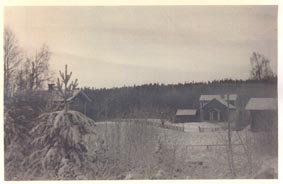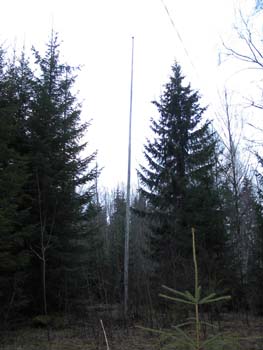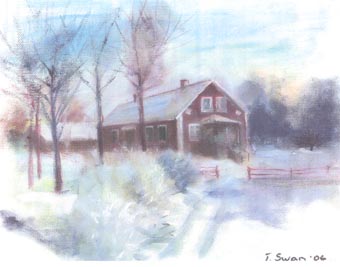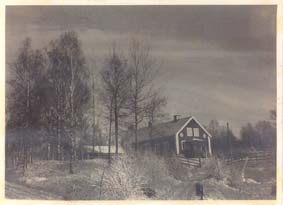|
The world
seemed to be coming to an end the day I heard that we were to move to
a small village in Bergslagen by the name of Backegruvan. Dad and all
my friends lived in Halmstad, so why couldn't we just stay there? Mom
had found a job teaching a total of eight first and second grade kids
in that no doubt godforsaken place--probably for ever--and I was one
of them, since I was to enter second grade that fall. By the way, the
eight of us were to constitute the entire student body of that school.
The hamlet couldn't even be found on a map, all we knew was that it
was supposed to be located near Lindesberg and Riddarhyttan, or some
places like that. Nobody listened to my objections, so all I could do
was sulk. I did just that for several days, as a matter of fact.
Many a year has gone by since then. Right now I am sitting in the middle
of the North American Continent, reminiscing. And my memories from those
two years we spent in Backegruvan keep on multiplying the more I think.
That's why I decided to write them down, mostly for the sake of my immediate
family, but with some luck perhaps others will find some enjoyment in
reading them as well, for you see, those two years turned out to be
a period of happy days, peace, and a sense of security never again equalled
in my life. In a way I now wish they had lasted for ever, just like
I feared they would in the beginning....
This is how I think I perceived the world in those days: There was peace
on earth (except perhaps in Korea which was a long ways off), the king
sat on a throne in Stockholm and under him was a governor of some sort,
and under the governor was the principal of several surrounding schools
in our area. Lowest in rank, but not least, came Nils Lilja who was
ancient and who lived right next to the deserted mine hole in the middle
of the village. (It must surely have taken an awful lot of courage to
live that close to the big opening in the ground, filled with black
water and probably bottomless). Nils Lilja and his wife Ebba took care
of the heating, cleaning, and maintenance of the school house. They
could answer any questions about the village and a great many other
places in the vicinity. Thus they must be almost all-knowing and worthy
of the utmost respect. With the king, the governor, the principal, and
Nils Lilja in charge of things, all seemed well. Nothing unpleasant
could possibly happen as long as they stayed where they were supposed
to be.
And nothing unpleasant did happen during the two years we lived in Backegruvan.
Come to think of it, hardly anything happened at all. Looking back at
it, time seems to have stood still. More or less, anyway.
We traveled from Halmstad to Bergslagen by train, as was most customary
in those days. The railroad ended in a narrow-gauge stretch, starting
just before we reached Riddarhyttan.
The furniture we brought with us was all made of dark, heavy oak with
beveled mirrors and pretty carvings. Dad had bought it at an auction
just before our departure and I can still remember how satisfied he
was with the reasonable price he had paid for the whole lot.
|
|
But how
would I ever learn to find my way in the rest of that huge house? Everything
seemed so big, so light, so newly varnished. The smell of varnish still
reminds me of school. Even the outdoor toilets were freshly varnished
and had an expanse that could serve four (or was it five?) kids at the
same time. The wood shed was in the same outbuilding along with a small
carpentry shop and another room of uncertain purpose up the stairs on
the second floor.
There were apple trees, lilac bushes, and peonies in the huge garden.
In the middle of a lawn stood a flag pole, and we had a wide area to
play in, covered with the coursest gravel I had ever seen. Almost like
cobble stones. There were two gates and a beautiful maple tree had been
planted at the larger one.
A little creek with crystal clear water ran outside the fence, circling
almost the entire house. It was bordered by willow bushes. Thousands
of white wood-anemones grew there and also among the many neighboring
birch trees in the springtime. A little farther out was the beginning
of the real forest, consisting mainly of spruce with deep, soft moss
underneath. And way beyond that, at a safe distance, was the rest of
the world of which I knew very little and which at the present time
was of no concern to me at all.
The village itself consisted of 7-9 farm houses, painted red and with
white gables just like the school house. They were spread out at a small
distance from each other with fields and meadows between them. In the
middle was a Methodist prayer house and a stone's throw from there was
the little country store, owned and operated by Nils Lilja. It was kept
open at various hours or when somebody knocked at the door of his house
and asked to go down and buy something. The ceiling in the little store
was very low. On the counter was an old-fashioned scale, requiring much
time and patience to balance with the weights in one bowl and the merchandise
in the other. Once the groceries to be purchased had been thorougly
weighed, they had to be individually wrapped in white paper which was
kept in a big dispenser on the counter. And, as a final touch, paper
tape had to be applied to keep the parcels from coming open. The tape
had to be dampened in order to stick.
Nils Lilja had a brother by the name of Karl who lived right next to
the store. Karl was married to a sister of Ebba's and their eighteen-year-old
daughter Maj-Britt did the cooking of the hot school lunches for us.
It was invariably very wholesome food (although we were too young to
appreciate some of it in those days), such as mashed potatoes and turnips,
grated carrots with raisins in them, and fish dumplings. She used to
polish the wood stove until it sparkled. Her boyfriend worked in Greenland
and she used to call him on our telephone (the only one in the village)
once in a while.
Nils Lilja also used to sell honey out of his own beehives for two kroner
a jar.
|
|
Between
the prayer house and the school was a farm inhabited by two elderly
sisters, Hanna and Gerda Berggren. They used to cook for the itinerant
preacher that sometimes paid a visit, and Hanna also taught Sunday School.
I remember how once she gave every child a piece of cardboard with a
picture of an apple tree on it. Each time we put in our attendance,
she handed us a little red paper apple to be glued on the tree, until,
hopefully, the tree would be loaded with fruit. It was at the Berggrens'
that I first saw a mangling-machine and a cream-separator, both of which
fascinated me a great deal.
|
 Tiius
photo from 1950
Tiius
photo from 1950 |
|
Two strips
of grass grew between the wheel tracks on the road going through the
village. Only one car normally frequented our neighborhood. It was the
old squarish taxi cab that brought the kids to school from other villages
and also picked up milk, deposited at the mine hole by the farmers,
to be taken to some far-away dairy. The local vehicle most often seen
was the horse-drawn wagon with wooden wheels belonging to the Pettersson
family living a little ways beyond the school house. That's where the
road ended. That's also where Kerstin and Hasse lived, the only two
children in the village, not counting myself. Kerstin was my senior
by a year and Hasse was a couple years younger.
Talking about the gravel road, our 'main street' through the village,
it was closed off at a couple of places by gates that had to be opened
and shut each time one passed through in order to keep the cattle confined
to where they belonged.
I just now remembered another vehicle local to our village. It was the
bicycle used by Walter Berggren (I believe that was his name) to carry
mail with, six days a week, come rain or shine. He must have spent 4/5
of his life on that bicycle. A quiet and patient-looking man. Thanks
to him we were able to get letters, newspapers, and once in a while
even packages ordered from Ahlen & Holm in Stockholm.
Speaking of news, there was certainly no shortage of that in those days
either. As I already mentioned, we had our daily papers and also the
daily news broadcast at precisely 19 o'clock from Stockholm. Mom always
assumed a tense expression while listening to the news and I wasn't
allowed to come with any interruptions while the business-like voice
on the radio ground on and on. Ever since then I have harbored a distinct
aversion to news, which, as a matter of fact, seems to get stronger
as time goes on. I wonder how come...
As I said before, we also had a telephone, so communicationwise there
was never any basis for complaint. Our phone number was 'Granhultsbruk
24'.
The social life among neighbors was not overly lively, but always picked
up around birthdays and name-days. All names, first, middle, and, if
applicable, third names, were celebrated with the customary coffee,
cake, and seven kinds of cookies, if not more. Always home-baked, of
course. Many older folks had a liking for drinking their coffee from
a saucer instead of a cup, frequently with a lump of sugar in their
mouth to strain the coffee through. And the coffee was never brewed,
it was first ground with a hand operated grinder and then boiled on
the wood stove.
Everybody from the village and the surrounding area used to gather at
the school house on certain memorable occasions. Once I remember that
we had a so called parish catechetical meeting, conducted by a vicar
from Ramsberg, a far-away place I never had a chance to visit. At other
times many people came to attend the children's Christmas program. I
still remember how once we girls were made to perform a ballet-like
thing, dressed in white skirts of crinkled paper. The raised area of
the classroom where the organ and teacher's desk, with the blackboard
in the background, used to be, served as stage. Mom always practiced
on that organ every evening after school to make sure that the music
would be just right at morning prayer-time the following day. Not that
I think any of us kids would have noticed any sour notes. We mostly
sort of mumbled through the singing anyway, without much enthusiasm.
Now I tend to get sentimental thinking of the beautiful hymns we had
in those days and wish I had memorized the words a little better.
During the time of Advent we each had a little candle lit on our desk,
right next to the cavity for the ink well, all through morning prayer.
What a Christmassy feeling that gave us!
During break time the girls mostly used to gather on once side of the
play ground and the boys on the other. The girls had their hair tied
up with silk ribbons of various colors and they wore striped or checkered
pinafores and knitted button-up sweaters. The boys frequently wore knickers,
socks with diamond patterns, and waistcoats. Rubber boots were often
worn by all due to the climate. In the wintertime we always wore ski
boots.
The winters were wonderful. Always lots of snow and much skiing, mostly
the cross-country variety. Every household owned at least one so called
chair-toboggan which provided occasions for some of the most fun-filled
escapades of the season. Of course, those were things we did mostly
in our spare time, away from school. It was exhilarating to hook up
several of those toboggans in a row and then take off down-hill, each
kid sitting on his own conveyance. But it was also dangerous, since
the smallest pebble in the snow could easily upset the whole train and
cause everybody to fly head first into space. But it was fun as long
as it lasted.
As soon as most of the snow had melted away, Mom and I resumed our long
walks in the woods. In the spring there was an abundance of morels to
be picked and later in the year 'regular' mushrooms. I can still conjure
up the moaning of the wind in the trees and the smell of the damp ground
in my imagination. Here and there we happened upon little round openings
in the woods, all covered with fresh light-green grass. Those marked
the place where there had recently been a charring stack, carefully
tended to night and day by a man staying in a little hut built of spruce
branches on the very edge of the clearing.
We sometimes lost our way and didn't get back home until after dark.
And once during our wanderings we found a little lake deep in the forest.
Later we learned that it was called Haraldsjon. The water was so clear
that one could easily see the pebbles on the bottom quite a long distance
from the shore. Next to the lake was an abandoned farm house with a
barn built of logs and with one long side of the second story protruding
over the lower part, the kind of barn one can find pictured in history
books when reading about the 16th century, the time of Gustav Vasa.
Another ancient log structure could be found a little ways from where
the road to Riddarhyttan branched off. It looked like it might have
been a blacksmith's shop or something of that nature a very long time
ago. It was surrounded by lilies of the valley in the springtime, one
of my favorite flowers.
There was of course an infinite variety of all sorts of other plants
as well. Walking along the road in the early mornings, especially toward
fall when the dew was caught in the many spiderwebs covering the plants,
the whole place was set sparkling by the sun hitting it from just the
right angle.
|




